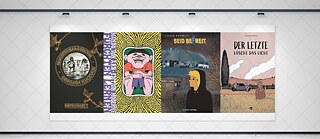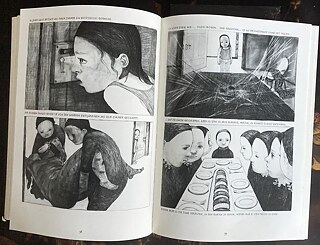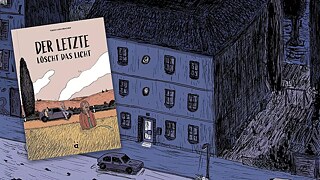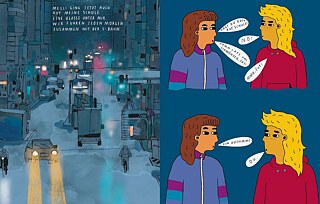Cherrypicker
Excellent comic books

New graphic novels demonstrate the diversity of the genre. Anke Feuchtenberger's magnum opus was honoured as literature, Sandra Rummler looks back on East Berlin and the post-reunification period. And the two Swiss authors Nando von Arb and Tobias Aeschbacher were awarded for works that could not be more different.
Anke Feuchtenberger has not only reached comic Olympus with her Genossin Kuckuck (Comrade Cuckoo). Jan-Paul Koopmann, for example, describes the extensive autobiographical pictorial narrative as a magnum opus in the taz. Genossin Kuckuck is an absolutely unusual graphic novel, exuberant in its visual and narrative ideas. The boundaries between reality and the supernatural are fluid, experiences become dream images. A clear interpretation is impossible. A girl flees from a dreary to cruel reality into fantasy worlds full of animals and plants, but there is no escape, because the illustrator's fantastic images are not beautiful, but create an eerie and threatening scene.
The nomination of Feuchtenberger's work for the Leipzig Book Fair Prize in the fiction category came as a surprise this year. The jury praised Feuchtenberger not only for her "magical, dark images", which tell the story of a complex childhood and youth in Eastern Germany, "repeatedly open up fantastic depths... into the collective unconscious" and create their own mythology, but also: "A comic book that takes such an aesthetic from the autofictional genre - that is a novelty in German-language literature". This was therefore an accolade for the graphic novel genre, even if there were of course those who doubted whether it made sense to compare novels and graphic novels.
A comic about experiences of reunification
Sandra Rummler's comic debut Seid befreit (Be liberated) also begins in East Germany, in East Berlin to be precise. Like the author, the main character Mo was born there in 1976. Based on her own experiences, Rummler describes Mo's childhood in the GDR and how she experienced the fall of the Berlin Wall and the time that followed. When Mo moves to West Berlin after the fall of the Wall, she is exhausted by the colourful world of goods in the evenings. She is "glad to return to the dark and empty part of Berlin". For the adolescent, the time after reunification is associated with the promise of an almost anarchic freedom, but the dark side soon becomes apparent. Mo's parents lose their jobs, her mother is forced to work as a cashier in a supermarket and Mo is threatened by neo-Nazis and called a stupid „Ossi“ (pejorative for East Germans) at school. "Today I live in another country without ever having moved," they say. The reunion with a friend who was thought to be lost is ultimately a small happy ending.Compared to Genossin Kuckuck, Rummler's story is much more realistic. In terms of colour, the environment is mostly kept dark and gloomy, at times blurring like watercolours, while the figures stand out clearly from the background with brighter and clearer colours. Birte Förster's conclusion in the Tagesspiegel: "With her brilliant, expressive graphic novel, Sandra Rummler has created a graphic memorial to the special time of reunification and the country of her childhood".
Panic attacks and a crazy crook story
As always, one of the highlights of this year's Comic Salon in Erlangen was the presentation of the Max and Moritz awards. Feuchtenberger and Rummler were also among the nominees. But the prizes went to others. Nando von Arb was honoured as best German-language comic for his graphic novel Fürchten lernen (Learning to fear). In it, the Zurich-based author deals with very different personal experiences of fear. Already as a child, he suffered from anxiety disorders and panic attacks. In terms of illustrations, the jury found Fürchten lernen to be "simply spectacular. Most pages consist of a single drawing, elsewhere two or three panels flow together into a masterfully designed picture. The drawings are dense and colourful, stylised and expressive, abstract and sensual - ... a dizzying ghost train through a maze of fears. And yet Learning to Fear also has a cheerful and whimsical side. This humour is perhaps proof that von Arb has overcome one or two fears".The prize for the best German-language comic debut went to comic artist and illustrator Tobias Aeschbacher, who lives in Biel, Switzerland, and tells a crazy crook story in Der Letzte löscht das Licht (The last one turns off the light). Three gangsters break into a house but can't get out. They meet lots of crazy people and other criminals there. "In the end, everyone is dead. Just like in Shakespeare. Or Tarantino ... Aeschbacher's debut works wonderfully thanks to the great characters, the intricate plot, the Oscar-worthy dialogue and running gags and the snappy drawings" (from the jury statement).
Basel: Helvetiq, 2024. 128 p.
ISBN: 978-3-03964-040-9
Nando von Arb: Fürchten lernen
Zürich: Edition Moderne, 2023. 428 p.
ISBN: 978-3-03731-256-8
Anke Feuchtenberger: Genossin Kuckuck
Berlin: Reprodukt, 2023. 448 p.
ISBN: 978-3-95640-346-0
Sandra Rummler: Seid befreit
Berlin: avant-verlag, 2023. 264 p.
ISBN: 978-3-96445-101-9



